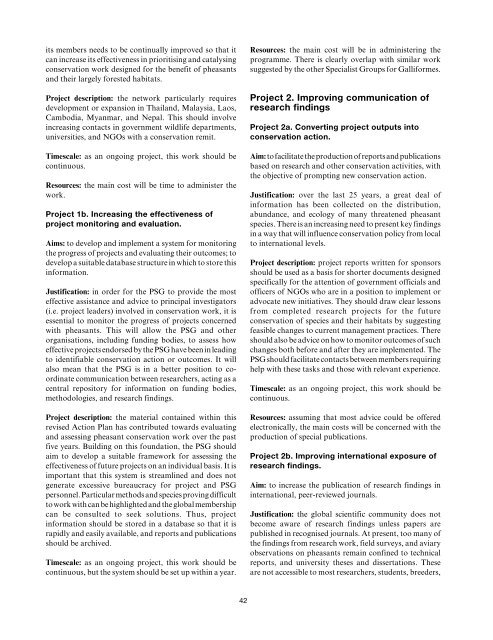Pheasants: Status Survey and Conservation Action Plan ... - IUCN
Pheasants: Status Survey and Conservation Action Plan ... - IUCN
Pheasants: Status Survey and Conservation Action Plan ... - IUCN
Create successful ePaper yourself
Turn your PDF publications into a flip-book with our unique Google optimized e-Paper software.
its members needs to be continually improved so that it<br />
can increase its effectiveness in prioritising <strong>and</strong> catalysing<br />
conservation work designed for the benefit of pheasants<br />
<strong>and</strong> their largely forested habitats.<br />
Project description: the network particularly requires<br />
development or expansion in Thail<strong>and</strong>, Malaysia, Laos,<br />
Cambodia, Myanmar, <strong>and</strong> Nepal. This should involve<br />
increasing contacts in government wildlife departments,<br />
universities, <strong>and</strong> NGOs with a conservation remit.<br />
Timescale: as an ongoing project, this work should be<br />
continuous.<br />
Resources: the main cost will be time to administer the<br />
work.<br />
Project 1b. Increasing the effectiveness of<br />
project monitoring <strong>and</strong> evaluation.<br />
Aims: to develop <strong>and</strong> implement a system for monitoring<br />
the progress of projects <strong>and</strong> evaluating their outcomes; to<br />
develop a suitable database structure in which to store this<br />
information.<br />
Justification: in order for the PSG to provide the most<br />
effective assistance <strong>and</strong> advice to principal investigators<br />
(i.e. project leaders) involved in conservation work, it is<br />
essential to monitor the progress of projects concerned<br />
with pheasants. This will allow the PSG <strong>and</strong> other<br />
organisations, including funding bodies, to assess how<br />
effective projects endorsed by the PSG have been in leading<br />
to identifiable conservation action or outcomes. It will<br />
also mean that the PSG is in a better position to coordinate<br />
communication between researchers, acting as a<br />
central repository for information on funding bodies,<br />
methodologies, <strong>and</strong> research findings.<br />
Project description: the material contained within this<br />
revised <strong>Action</strong> <strong>Plan</strong> has contributed towards evaluating<br />
<strong>and</strong> assessing pheasant conservation work over the past<br />
five years. Building on this foundation, the PSG should<br />
aim to develop a suitable framework for assessing the<br />
effectiveness of future projects on an individual basis. It is<br />
important that this system is streamlined <strong>and</strong> does not<br />
generate excessive bureaucracy for project <strong>and</strong> PSG<br />
personnel. Particular methods <strong>and</strong> species proving difficult<br />
to work with can be highlighted <strong>and</strong> the global membership<br />
can be consulted to seek solutions. Thus, project<br />
information should be stored in a database so that it is<br />
rapidly <strong>and</strong> easily available, <strong>and</strong> reports <strong>and</strong> publications<br />
should be archived.<br />
Timescale: as an ongoing project, this work should be<br />
continuous, but the system should be set up within a year.<br />
Resources: the main cost will be in administering the<br />
programme. There is clearly overlap with similar work<br />
suggested by the other Specialist Groups for Galliformes.<br />
Project 2. Improving communication of<br />
research findings<br />
Project 2a. Converting project outputs into<br />
conservation action.<br />
Aim: to facilitate the production of reports <strong>and</strong> publications<br />
based on research <strong>and</strong> other conservation activities, with<br />
the objective of prompting new conservation action.<br />
Justification: over the last 25 years, a great deal of<br />
information has been collected on the distribution,<br />
abundance, <strong>and</strong> ecology of many threatened pheasant<br />
species. There is an increasing need to present key findings<br />
in a way that will influence conservation policy from local<br />
to international levels.<br />
Project description: project reports written for sponsors<br />
should be used as a basis for shorter documents designed<br />
specifically for the attention of government officials <strong>and</strong><br />
officers of NGOs who are in a position to implement or<br />
advocate new initiatives. They should draw clear lessons<br />
from completed research projects for the future<br />
conservation of species <strong>and</strong> their habitats by suggesting<br />
feasible changes to current management practices. There<br />
should also be advice on how to monitor outcomes of such<br />
changes both before <strong>and</strong> after they are implemented. The<br />
PSG should facilitate contacts between members requiring<br />
help with these tasks <strong>and</strong> those with relevant experience.<br />
Timescale: as an ongoing project, this work should be<br />
continuous.<br />
Resources: assuming that most advice could be offered<br />
electronically, the main costs will be concerned with the<br />
production of special publications.<br />
Project 2b. Improving international exposure of<br />
research findings.<br />
Aim: to increase the publication of research findings in<br />
international, peer-reviewed journals.<br />
Justification: the global scientific community does not<br />
become aware of research findings unless papers are<br />
published in recognised journals. At present, too many of<br />
the findings from research work, field surveys, <strong>and</strong> aviary<br />
observations on pheasants remain confined to technical<br />
reports, <strong>and</strong> university theses <strong>and</strong> dissertations. These<br />
are not accessible to most researchers, students, breeders,<br />
42
















